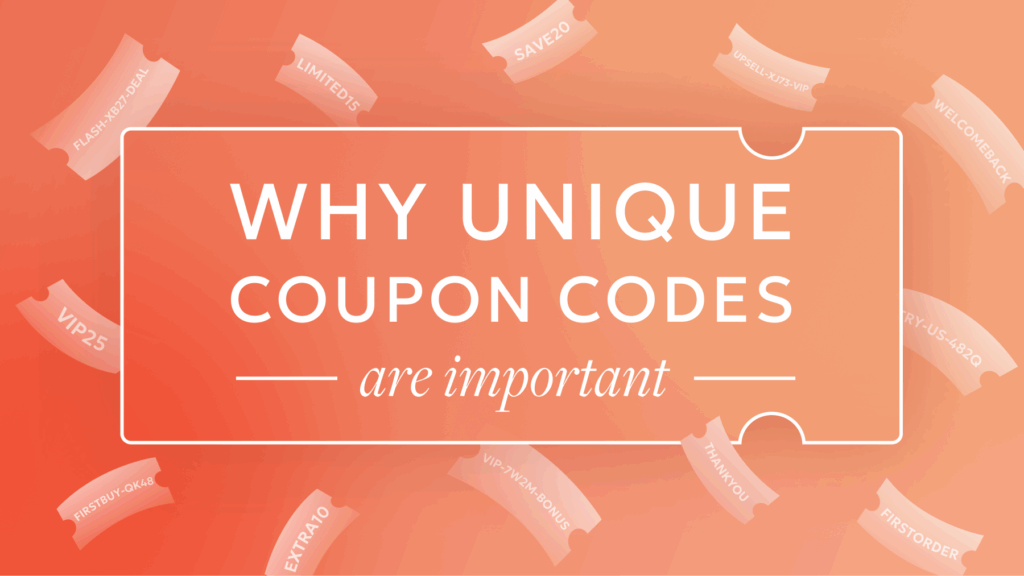In today’s hyper-competitive ecommerce environment, offering discounts is a proven way to increase conversions, re-engage hesitant shoppers, and drive urgency. However, the way those discounts are delivered, and more importantly, how they’re protected, can make or break your campaign’s effectiveness.
Coupon abuse results in approximately $89 billion in lost revenue annually, with 42% of businesses reporting challenges in effectively controlling their promotional offers.
One of the most overlooked tools in a marketer’s toolkit is the unique coupon code. When used properly, unique codes not only preserve promotional integrity but also protect margins and empower smarter performance tracking.
Let’s explore why they matter and how Upsellit ensures your discounts stay strategic and secure.
The Risks of Public (Static) Coupon Codes
With 62% of U.S. consumers actively looking for promo codes before making an online purchase, it’s clear that discounts play a major role in shopper decision-making. To capitalize on this behavior, many retailers turn to static coupon codes because they’re easy to implement and promote. But this convenience often comes at a cost.
1. Margin Erosion from Coupon Abuse
Static codes can quickly end up on third-party coupon sites, often within minutes of being launched. Once exposed, shoppers can apply them indiscriminately, even when they weren’t the intended audience. This abuse eats into margins and skews campaign performance.
2. Undermined Promotional Strategies
When shoppers rely on public codes rather than completing specific actions (like signing up for a newsletter or reaching a cart value threshold), your incentive strategy loses effectiveness. Worse, customers may abandon their cart in search of a code, introducing friction at the worst possible moment.
3. Inaccurate Attribution & Tracking
If everyone uses the same coupon code, how do you know which channels are truly driving results? Static codes muddy the waters, making it difficult to assess which touchpoints are most effective.
Why Unique Codes Solve These Problems
Unique coupon codes, which are generated individually for each user or interaction, help eliminate many of the pitfalls associated with static codes:
- Prevent Sharing: Unique codes can be set to single use, limited by time, or even tied to a specific user session.
- Support Personalization: Incentives can be tailored based on behavior, cart contents, or referral source.
- Enable Cleaner Attribution: Brands can track conversions back to the exact moment and method of delivery.
By delivering unique codes through on-site engagement tools, email follow-ups, or exit-intent strategies, brands ensure the right shopper receives the right offer at the right time.
How Upsellit Protects and Powers Unique Coupon Code Strategies
At Upsellit, we understand that the effectiveness of unique coupon codes hinges on how they’re delivered and safeguarded. That’s why we developed Upsellit’s Coupon Experience to combat common threats to coupon performance.
Coupon Corrector: Protecting Against Extension Interference
48% of shoppers made an unplanned purchase after discovering an online coupon, highlighting how influential a well-timed discount can be.
Upsellit’s Coupon Corrector actively detects failed coupon codes that cause users to abandon checkout. To recover sales, Coupon Corrector provides a pre-approved discount. It ensures that only the appropriate, brand-approved offer is applied, one earned through legitimate engagement rather than pulled from unauthorized sources. This protects revenue while preserving a smooth and consistent shopping experience.
Ad Extension Manager: Stopping Leaks Before They Start
Coupon browser extensions like Honey or Capital One Shopping interfere with coupon strategies by automatically applying public codes. This can prompt shoppers to abandon their carts in search of additional savings or cause checkout frustration as irrelevant codes are tested.
Upsellit’s Ad Extension Manager prevents unwanted extension traffic from inserting unauthorized codes or manipulating the checkout process. With Upsellit’s blocker in place, you keep full control over how and where offers appear, and ensure paid traffic doesn’t drive unearned discounts.
Coupon Analytics: Uncovering Code-Level Performance
Coupons aren’t just tools for conversion, they’re rich sources of shopper insight. Without clear visibility into how and where codes are used, marketers are left in the dark about campaign effectiveness and revenue impact.
Upsellit’s Coupon Analytics delivers real-time visibility into unique code activity, enabling brands to track performance by channel, behavior, and campaign. It helps identify trends, flag suspicious use patterns, and refine discounting strategies based on real-time data.
With Coupon Analytics, brands gain the transparency they need to protect margins, improve attribution accuracy, and make smarter promotional decisions, turning every code into a source of actionable insight.
Smarter Discounts. Stronger Margins.
Unique coupon codes are more than a tactical fix, they’re a strategic upgrade. By pairing them with Upsellit’s protection tools, brands can:
- Maintain profitability
- Deliver seamless, trustworthy promotions
- Reduce reliance on blanket discounting by increasing efficiency and personalization
But don’t just take our word for it. See how major retailers use Upsellit’s Coupon Corrector, Coupon Analytics, and Ad Extension Manager to reclaim lost revenue and drive meaningful growth. Download the Coupon Experience Case Study to explore the results, strategy, and technology in action.
